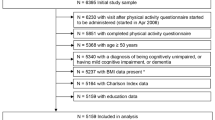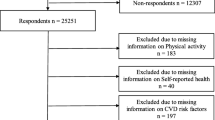Abstract
Background and aims: This study aimed at examining the association between unhealthy lifestyle in young age, midlife and/or old age and physical decline in old age, and between chronic exposure to an unhealthy lifestyle throughout life and physical decline in old age. Methods: The study sample included 1297 respondents of the Longitudinal Aging Study Amsterdam (LASA). Lifestyle in old age (55–85 y) was assessed at baseline, whereas lifestyle in young age (around 25 y) and midlife (around 40 y) were assessed retrospectively. Lifestyle factors included physical activity, body mass index (BMI), number of alcohol drinks per week and smoking. Physical decline was calculated as a change in physical performance score between baseline and six-year follow-up. Results: Of the lifestyle factors present in old age, a BMI of 25–29 vs BMI <25 kg/m2 (OR=1.6; 95% CI: 1.1–2.2) and a BMI of ≥30 vs BMI <25 kg/m2 (OR=1.8; 95% CI: 1.2–2.7) were associated with physical decline in old age. Being physically inactive in old age was not significantly associated with an increased risk of physical decline, although, being physically inactive in both midlife and old age increased the odds of physical decline in old age to 1.6 (95% CI: 1.1–2.4), compared with respondents who were physically inactive in midlife and physically active in old age. Being overweight in both age periods was associated with an OR of 1.5 (95% CI: 1.1–2.2) Conclusions: These data suggest that overweight in old age, and chronic exposure to physical inactivity or overweight throughout life, increases the risk of physical decline in old age. Therefore, physical activity and prevention of excessive weight at all ages should be stimulated, to prevent physical decline in old age.
Similar content being viewed by others
References
Stel VS, Smit JH, Pluijm SM, Lips P. Balance and mobility performance as treatable risk factors for recurrent falling in older persons. J Clin Epidemiol 2003; 56: 659–68.
Guralnik JM, Simonsick EM, Ferrucci L, et al. A short physical performance battery assessing lower extremity function: association with self-reported disability and prediction of mortality and nursing home admission. J Gerontol 1994; 49: M85–94.
Hirvensalo M, Rantanen T, Heikkinen E. Mobility difficulties and physical activity as predictors of mortality and loss of independence in the community-living older population. J Am Geriatr Soc 2000; 48: 493–8.
Stuck AE, Walthert JM, Nikolaus T, Bula CJ, Hohmann C, Beck JC. Risk factors for functional status decline in communityliving elderly people: a systematic literature review. Soc Sci Med 1999; 48: 445–69.
Reid MC, Boutros NN, O’Connor PG, Cadariu A, Concato J. The health-related effects of alcohol use in older persons: a systematic review. Subst Abus 2002; 23: 149–64.
Launer LJ, Harris T, Rumpel C, Madans J. Body mass index, weight change, and risk of mobility disability in middle-aged and older women. The epidemiologic follow-up study of NHANES I. JAMA 1994; 271: 1093–8.
Pinsky JL, Leaverton PE, Stokes J III. Predictors of good function: the Framingham Study. J Chronic Dis 1987; 40(suppl 1): 159S–67S.
Guralnik JM, Kaplan GA. Predictors of healthy aging: prospective evidence from the Alameda County Study. Am J Public Health 1989; 79: 703–8.
Ferraro KF, Su YP, Gretebeck RJ, Black DR, Badylak SF. Body mass index and disability in adulthood: a 20-year panel study. Am J Public Health 2002; 92: 834–40.
Peeters A, Bonneux L, Nusselder WJ, de Laet C, Barendregt J. Adult obesity and the burden of disability throughout life. Obes Res 2004; 12: 1145–51.
Hillsdon MM, Brunner EJ, Guralnik J, Marmot MG. Prospective study of physical activity and physical function in early old age. Am J Prev Med 2005; 28: 245–50.
Deeg DJH, Knipscheer CPM, van Tilburg W, Eds. Autonomy and well-being in the aging population: concepts and design of the Longitudinal Aging Study Amsterdam. Netherlands Institute of Gerontology, Bunnik, The Netherlands, 1993.
Smit JH, de Vries MZ, Poppelaars JL. Data-collection and fieldwork procedures. In Deeg DJH, Beekman ATF, Kriegsman DMW, Westendorp-de Sérière M, Eds. Autonomy and well-being in the aging population, II: Report from the Longitudinal Aging Study Amsterdam 1992–1996. Amsterdam: VU University Press, 1998: 9–20.
Stel VS, Pluijm SMF, Deeg DJH, Smit JH, Bouter LM, Lips P. Functional limitations and poor physical performance as independent risk factors for self-reported fractures in older persons. Osteoporos Int 2004; 15: 742–50.
van Schoor NM, Smit JH, Pluijm SMF, Jonker C, Lips P. Different cognitive functions in relation to falls among older persons. Immediate memory as an independent risk factor for falls. J Clin Epidemiol 2002; 55: 855–62.
de Boer MR, Pluijm SMF, Lips P, et al. Different aspects of visual impairment as risk factors for falls and fractures in older men and women. J Bone Miner Res 2004; 19: 1539–47.
Puts MTE, Lips P, Deeg DJH. Static and dynamic measures of frailty predicted decline in performance-based and self-reported physical functioning. J Clin Epidemiol 2005; 58: 1188–98.
Stel VS, Smit JH, Pluijm SMF, Visser M, Deeg DJH, Lips P. Comparison of the LASA Physical Activity Questionnaire with a 7-day diary and pedometer. J Clin Epidemiol 2004; 57: 252–8.
Dik MG, Deeg DJH, Visser M, Jonker C. Early life physical activity and cognition in old age. J Clin Exp Neuropsychol 2003; 25: 643–53.
World Health Organization. Obesity: preventing and managing the global epidemic. WHO Technical Report Series, No. 894. Geneva, WHO, 2000.
Central Bureau of Statistics. Health Interview Questionnaire. The Hague: CBS, 1989.
Garretsen HFL, Knibbe RA. Alkohol Prevalentie Onderzoek Rotterdam/Limburg, Landelijk Eindrapport, Ministerie van Welzijn, Volksgezondheid en Cultuur, Leidschendam 1983 (in Dutch).
Kriegsman DM, Penninx BW, van Eijk AJ, Deeg DJ. Self-reports and general practitioner information on the presence of chronic diseases in community-dwelling elderly: a study on the accuracy of patients’ self-reports and on determinants of inaccuracy. J Clin Epidemiol 1996; 49: 1407–17.
Radloff LS. The CES-D scale: a self-report depression scale for research in the general population. Appl Psych Meas 1977; 1: 385–401.
Folstein MF, Folstein SE, McHugh PR. ‘Mini-mental state’: a practical method for grading the cognitive state of patients for the clinician. J Psychiatr Res 1975; 12: 189–98.
Edwards DW, Yarvis RM, Mueller DP, Zingale HC, Wagman WJ. Test-taking and the stability of adjustment scales: can we assess patient deterioration? Evaluation Quarterly 1978; 2: 275–92.
Speer DC, Greenbaum PE. Five methods for computing significant individual client change and improvement rates: support for an individual growth curve approach. J Consult Clin Psychol 1995; 63: 1044–8.
LaCroix AZ, Guralnik JM, Berkman LF, Wallace RB, Satterfield S. Maintaining mobility in late life. II. Smoking, alcohol consumption, physical activity, and body mass index. Am J Epidemiol 1993; 137: 858–69.
Visser M, Langlois J, Guralnik JM, et al. High body fatness, but not low fat-free mass, predicts disability in older men and women: the Cardiovascular Health Study. Am J Clin Nutr 1998; 68: 584–90.
Visser M, Pluijm SM, Stel VS, Bosscher RJ, Deeg DJ. Physical activity as a determinant of change in mobility performance: the Longitudinal Aging Study Amsterdam. J Am Geriatr Soc 2002; 50: 1774–81.
Jensen GL, Friedmann JM. Obesity is associated with functional decline in community-dwelling rural older persons. J Am Geriatr Soc 2002; 50: 918–23.
Li Wang MS, van Belle G, Kukull WB, Larson EB. Predictors of functional change: a longitudinal study of non-demented people aged 65 and older. J Am Geriatr Soc 2002; 50: 1525–34.
Haveman-Nies A, de Groot LC, Van Staveren WA, Survey in Europe Nutrition and the Elderly: a Concerted Action study. Relation of dietary quality, physical activity, and smoking habits to 10-year changes in health status in older Europeans in the SENECA study. Am J Public Health 2003; 93: 318–23.
Wannamethee SG, Ebrahim S, Papacosta O, Shaper AG. From a postal questionnaire of older men, healthy lifestyle factors reduced the onset of and may have increased recovery from mobility limitation. J Clin Epidemiol 2005; 58: 831–40.
Taaffe DR, Duret C, Wheeler S, Marcus R. Once-weekly resistance exercise improves muscle strength and neuromuscular performance in older adults. J Am Geriatr Soc 1999; 47: 1208–14.
Sartorio A, Lafortuna CL, Agosti F, Proietti M, Maffiuletti NA. Elderly obese women display the greatest improvement in stair climbing performance after a 3-week body mass reduction program. Int J Obes Relat Metab Disord 2004; 28: 1097–104.
Jensen GL, Roy MA, Buchanan AE, Berg MB. Weight loss intervention for obese older women: improvements in performance and function. Obes Res 2004; 12: 1814–20.
Noale M, Minicuci N, Bardage C, et al. Predictors of mortality: an international comparison of socio-demographic and health characteristics from six longitudinal studies on aging: the CLESA project. Exp Gerontol 2005; 40: 89–99.
Haveman-Nies A, de Groot LCPGM, Burema J, Amorim-Cruz JA, Osler M, van Staveren WA. Dietary quality and lifestyle factors in relation to 10-year mortality in older Europeans. Am J Epidemiol 2002; 156: 962–8.
Wang BWE, Ramey DR, Schettler JD, Hubert HB, Fries JF. Postponed development of disability in elderly runners. Arch Intern Med 2002; 162: 2285–94.
Wareham NJ, Rennie KL. The assessment of physical activity in individuals and populations: why try to be more precise about how physical activity is assessed. Int J Obes Relat Metab Disord 1998; 22(suppl 2): S30–8.
Falkner KL, McCann SE, Trevisan M. Participant charateristics and quality of recall of physical activity in the distant past. Am J Epidemiol 2001; 154: 865–72.
Author information
Authors and Affiliations
Corresponding author
Rights and permissions
About this article
Cite this article
Pluijm, S.M.F., Visser, M., Puts, M.T.E. et al. Unhealthy lifestyles during the life course: association with physical decline in late life. Aging Clin Exp Res 19, 75–83 (2007). https://doi.org/10.1007/BF03325214
Received:
Accepted:
Published:
Issue Date:
DOI: https://doi.org/10.1007/BF03325214




